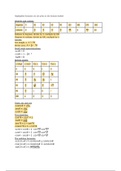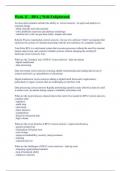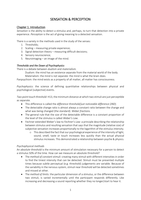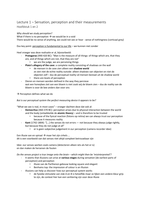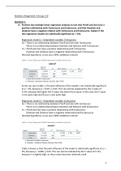AS & A Level Physics 9702 REVISION
NOTES
1.1 Physical quantities
b)(1) make reasonable estimate of Frequency Of Audible Sound Wave:
Humans can detect sounds in a frequency range from about 20 Hz to 20 kHz. (Human
infants can actually hear frequencies slightly higher than 20 kHz, but lose some
high-frequency sensitivity as they mature; the upper limit in average adults is often closer to
15-17 kHz.)
1.1 Physical quantities
b)(2) make reasonable estimate of The Wavelength, in nm, of Ultraviolet Radiation:
=> If you remember the Order Of Magnitude of electromagnetic radiation then you can
answer this question easily. Ultraviolet radiation has wavelength from meter. So you can put
any value between this. Answer: 50nm
1.1 Physical quantities
b)(3) make reasonable estimate of The Mass Of The Plastic 30cm Ruler:
=> A plastic ruler cannot have mass greater or equal to KG. But a 500 gram object will
obviously be much heavier than a plastic ruler. So, it must be in the range of 30g to 100g.
Answer: 50g
1.1 Physical quantities
b)(4) make reasonable estimate of Density Of Air At Atmospheric
=> As we know the value of Atmospheric pressure if approximately 100,000 pascals. Let's
consider the height of the air that surrounds the earth is 10000m. Now using the formula
Pressure = density gravity height, we can find out the density. Density: 1 Kg/m^3
1.1 Physical quantities
b)(5) make reasonable estimate of
1)Mass of 3 cans (330 ml) of Coke
2)Mass of a medium-sized car
3)Length of a football field
4)Reaction time of a young man
1)1 kg
2)1000 kg
3)100 m
4)0.2 s
1.1 Physical quantities
b)(6)Estimate the average running speed of a typical 17-year-old‟s 2.4-km run.
,velocity = distance / time
=2400 / (12.5 x 60)
= 3.2 ≈3 ms-1
1.1 Physical quantities
b)(7)Which estimate is realistic?
A)The kinetic energy of a bus travelling on an expressway is 30000J
B)The power of a domestic light is 300W.
C)The temperature of a hot oven is 300 K
D)The volume of air in a car tyre is 0.03 m^3.
A)A bus of mass m travelling on an expressway will travel between 50 to 80 kmh-1, which is
13.8 to 22.2 ms-1. Thus, its KE will be approximately ½ m(182) = 162m. Thus, for its KE to
be 30000J: 162m = 30000. Thus, m = 185kg, which is an absurd weight for a bus; ie. This is
not a realistic estimate.
B)A single light bulb in the house usually runs at about 20W to 60W. Thus, a domestic light
is unlikely to run at more than 200W; this estimate is rather high.
C)300K = 27 0C. Not very hot.
D)Estimating the width of a tyre, t, is 15 cm or 0.15 m, and estimating R to be 40 cm and r to
be 30 cm,
volume of air in a car tyre is
= π(R2 - r2)t
= π(0.42 - 0.32)(0.15)
= 0.033 m3
≈ 0.03 m3 (to one sig. fig.)
1.2 SI units
a) recall the following SI base quantities and their units:
1)mass (kg),
2)length(m),
3)time (s),
4)current (A),
5)temperature (K),
6)amount of substance (mol)
1.2 SI units
b) express derived units as products or quotients of the SI base units and
use the named units listed in this syllabus as appropriate
, 1.1 Physical quantities
b)(4) make reasonable estimate of
1)Mass of 3 cans (330 ml) of Coke
2)Mass of a medium-sized car
3)Length of a football field
4)Reaction time of a young man
1)1 kg
2)1000 kg
3)100 m
4)0.2 s
1.2 SI units
c) use SI base units to check the homogeneity of physical equations
An equation is homogeneous if quantities
on BOTH sides of the equation has the
same unit
• E.g. s = ut + ½ at2
• LHS : unit of s = m
• RHS : unit of ut = ms-1 x s = m
• unit of at2 = ms-2 x s^2 = m
• Unit on LHS = unit on RHS
• Hence equation is homogeneous
P = ρgh2
• LHS ; unit of P = Nm-2 = kg m-1 s-2
• RHS : unit of ρgh2 = kg m-3(ms-2) (m^2) = kgs-2
• Unit on LHS =(not) unit on RHS
• Hence equation is not homogeneous
• Note: numbers has no unit
• some constants have no unit.
• e.g. Pi
1.2 SI units
d) use the following prefixes and their symbols to indicate decimal
submultiples or multiples of both base and derived units: pico (p),
nano(n),
micro (μ),
milli (m),
centi (c),
deci (d),
kilo (k),
mega (M),
giga (G),
tera(T)
NOTES
1.1 Physical quantities
b)(1) make reasonable estimate of Frequency Of Audible Sound Wave:
Humans can detect sounds in a frequency range from about 20 Hz to 20 kHz. (Human
infants can actually hear frequencies slightly higher than 20 kHz, but lose some
high-frequency sensitivity as they mature; the upper limit in average adults is often closer to
15-17 kHz.)
1.1 Physical quantities
b)(2) make reasonable estimate of The Wavelength, in nm, of Ultraviolet Radiation:
=> If you remember the Order Of Magnitude of electromagnetic radiation then you can
answer this question easily. Ultraviolet radiation has wavelength from meter. So you can put
any value between this. Answer: 50nm
1.1 Physical quantities
b)(3) make reasonable estimate of The Mass Of The Plastic 30cm Ruler:
=> A plastic ruler cannot have mass greater or equal to KG. But a 500 gram object will
obviously be much heavier than a plastic ruler. So, it must be in the range of 30g to 100g.
Answer: 50g
1.1 Physical quantities
b)(4) make reasonable estimate of Density Of Air At Atmospheric
=> As we know the value of Atmospheric pressure if approximately 100,000 pascals. Let's
consider the height of the air that surrounds the earth is 10000m. Now using the formula
Pressure = density gravity height, we can find out the density. Density: 1 Kg/m^3
1.1 Physical quantities
b)(5) make reasonable estimate of
1)Mass of 3 cans (330 ml) of Coke
2)Mass of a medium-sized car
3)Length of a football field
4)Reaction time of a young man
1)1 kg
2)1000 kg
3)100 m
4)0.2 s
1.1 Physical quantities
b)(6)Estimate the average running speed of a typical 17-year-old‟s 2.4-km run.
,velocity = distance / time
=2400 / (12.5 x 60)
= 3.2 ≈3 ms-1
1.1 Physical quantities
b)(7)Which estimate is realistic?
A)The kinetic energy of a bus travelling on an expressway is 30000J
B)The power of a domestic light is 300W.
C)The temperature of a hot oven is 300 K
D)The volume of air in a car tyre is 0.03 m^3.
A)A bus of mass m travelling on an expressway will travel between 50 to 80 kmh-1, which is
13.8 to 22.2 ms-1. Thus, its KE will be approximately ½ m(182) = 162m. Thus, for its KE to
be 30000J: 162m = 30000. Thus, m = 185kg, which is an absurd weight for a bus; ie. This is
not a realistic estimate.
B)A single light bulb in the house usually runs at about 20W to 60W. Thus, a domestic light
is unlikely to run at more than 200W; this estimate is rather high.
C)300K = 27 0C. Not very hot.
D)Estimating the width of a tyre, t, is 15 cm or 0.15 m, and estimating R to be 40 cm and r to
be 30 cm,
volume of air in a car tyre is
= π(R2 - r2)t
= π(0.42 - 0.32)(0.15)
= 0.033 m3
≈ 0.03 m3 (to one sig. fig.)
1.2 SI units
a) recall the following SI base quantities and their units:
1)mass (kg),
2)length(m),
3)time (s),
4)current (A),
5)temperature (K),
6)amount of substance (mol)
1.2 SI units
b) express derived units as products or quotients of the SI base units and
use the named units listed in this syllabus as appropriate
, 1.1 Physical quantities
b)(4) make reasonable estimate of
1)Mass of 3 cans (330 ml) of Coke
2)Mass of a medium-sized car
3)Length of a football field
4)Reaction time of a young man
1)1 kg
2)1000 kg
3)100 m
4)0.2 s
1.2 SI units
c) use SI base units to check the homogeneity of physical equations
An equation is homogeneous if quantities
on BOTH sides of the equation has the
same unit
• E.g. s = ut + ½ at2
• LHS : unit of s = m
• RHS : unit of ut = ms-1 x s = m
• unit of at2 = ms-2 x s^2 = m
• Unit on LHS = unit on RHS
• Hence equation is homogeneous
P = ρgh2
• LHS ; unit of P = Nm-2 = kg m-1 s-2
• RHS : unit of ρgh2 = kg m-3(ms-2) (m^2) = kgs-2
• Unit on LHS =(not) unit on RHS
• Hence equation is not homogeneous
• Note: numbers has no unit
• some constants have no unit.
• e.g. Pi
1.2 SI units
d) use the following prefixes and their symbols to indicate decimal
submultiples or multiples of both base and derived units: pico (p),
nano(n),
micro (μ),
milli (m),
centi (c),
deci (d),
kilo (k),
mega (M),
giga (G),
tera(T)


